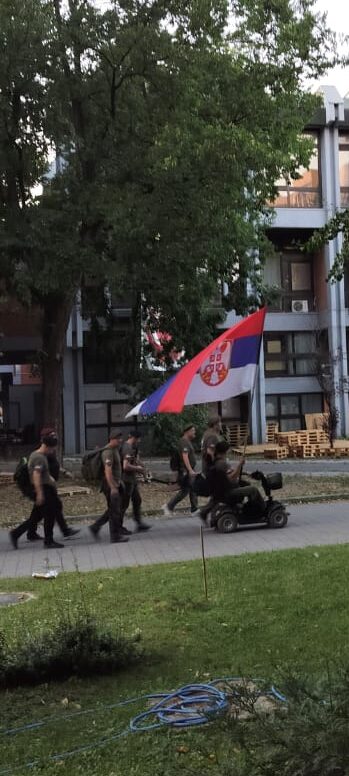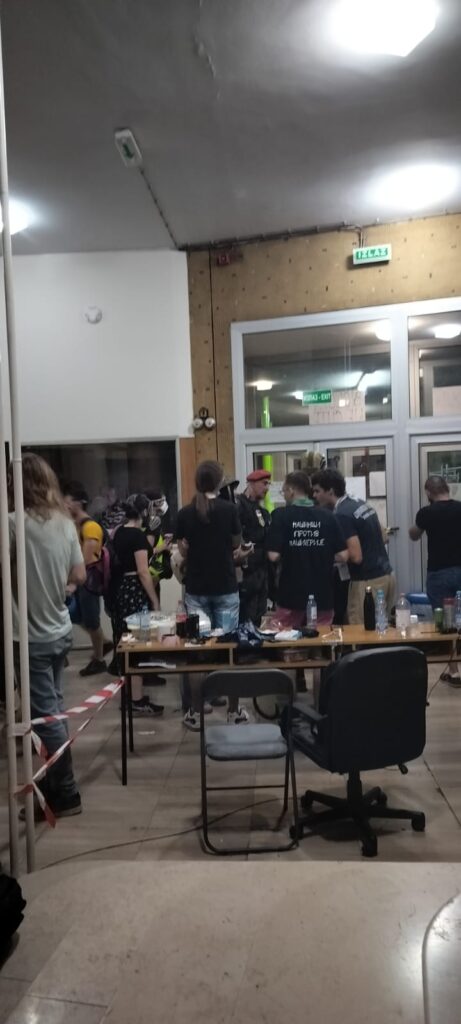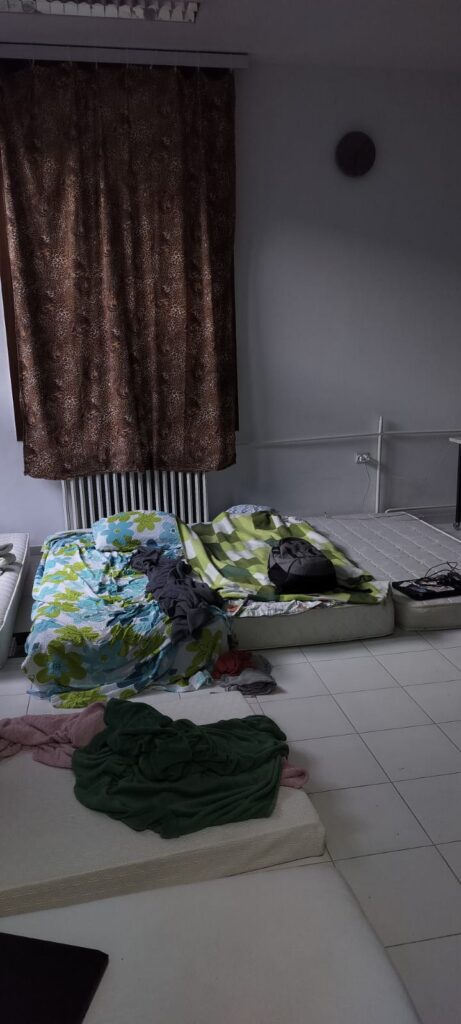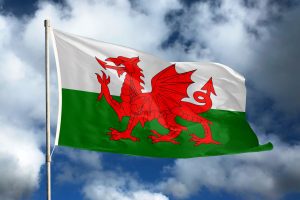September 5th, Novi Sad.
I arrived at 6PM, meeting other students in the Novi Sad University. The protest was set for an hour later. As I arrived at the Campus, we walked past the philosophy faculty.
Several policemen were guarding it. A few meters down the street, on the right, I was shown the science faculty by *Slavomir, a Serbian student.
On the occasion of the protest, this was the building where first aid would be hosted, as well as other students coming from other towns (like Belgrade and Kragujevac).
The inside of the faculty was all set up for the big day. Around 10,000 people were expected to come. Many had already brought their mattresses while students from the faculty stored food.
Around thirty medics formed the first-aid team, with clear labels on their shirts. Students continued to bring food, water and other basic necessities.
Slavomir gave cards with an SOS number, in case students were to be captured by the police. Shortly before 7PM, military veterans patrolled around the different faculties, who also supported the students. They were about thirty.

At 7PM, we were ready to go. We headed down the main road, where several students and related figures would hold speeches.
I asked Slavomir how he was feeling: “We are not nervous anymore, we’re used to it. He reminded me he had been on the streets since the beginning, ten months ago”.
Yet, anxiety remains: “In big protests, you never know what can happen with the big crowds. You are always anxious”, he admitted.
People came from all streets, joining each other in the boulevard. Several thousands attended, without a doubt. Every university and faculty had their own flag, in addition to the Serbian one. At that time, the police were nowhere to be seen.
Similarly to all protests, it started with a dozen minutes of silence, in honour of the victims who died in the train station crash of Novi Sad on November 1st, 2024.
Though it took some time, it eventually arrived in full silence. Crows shadowed a gloomy atmosphere, while drones flying over our heads were the only sounds to be heard.
Then, students of occupied faculties, which are the sports and philosophy, took turns to speak up against an illegitimate occupation.
For a free Serbia and the right to keep the campus police-free, they exclaimed.
So did a teacher of the philosophy faculty. It turned emotional when the mother of one of the victims took her turn: “I don’t know what to say”, she ended. But she knew that “there is no way I can not support you”.
Between the speeches, every student shouted several slogans as loudly as possible – the most notably being “Pumpaj”, translated to “pump it” – with a heart, symbolizing a movement calling for Serbia’s rebirth, for its heart had been emptied by corruption.
The goal of the students was clear: Besides wanting the police to leave the university, they requested accelerated elections, which President Vučić has refused to do this far. This lasted about an hour.
Three employees of the Novi Sad Medical Emergency Services, fired for refusing to respond to an unofficial SNS (Vučić’s nationalist party) call to their offices came to help, using their talents to support the students movement instead.
It was about 8:30 when students had decided to press forward with their mission: To free the occupied faculty of philosophy, just round the corner.
The police stood firm, and did not move an inch.
Students came closer, and continued to sing thematic songs. Among them several anti-Vučić chants. People lit flares in different colours while attempting to come closer to the blockade.
By 9PM, the tensions had already started. The police detonated several flash grenades, and everything went loose.
One, two, three. By the third flash, I had moved between the faculty of philosophy and science, in the knowledge chaos would soon unfold.
The third detonated loudly, and a megaphone told students to take refuge. Some did in the rector’s office, but most did, like me, in the guarded faculty of sciences.
I was helping students who were victims of tear gas, bringing them to the first aid station. As I looked for my friend in the building, more and more people rushed inside. Yet, students kept the crowd under control.
Despite remaining inside, with the door open, the gas came up to my eyes. I went from the helper to needing help.
With the assistance of the first-aid team the pain lasted around half an hour. More and more rushed inside, victims of the same thing.
With two other students, we tried to take refuge upstairs. Soon, we realized the gas felt stronger, after which we knew that it was not an option.
By that time, it was 10PM, and everyone was in the halls or the amphitheatres. Within half an hour, we knew that the police had completely taken control of the campus, an exit was no option.
We stayed inside, whilst I needed to update my relatives, worried for me. Most students were familiar with this situation. Food was soon given, while some students helped those who fell unconscious, still outside.
Soon after, several students had been captured by the police, forced to lie on the ground. Some of these included members of the first-aid team.
By 11:30 PM we knew that the police were only a few metres away, attempting to break through the small blockade of veterans who protected the faculty.
From their positions outside they kept spreading tear gas and are suspected to have used pepper bombs as well. All of this was unnecessary. Some students had tried to escape, and were hunted down by the police.
The dean, supportive of the protest, had been beaten by the police but was successfully taken to the makeshift ER. By that point, the police and government-hired hooligans were going for anyone they could find.

As we were waiting inside, we were told we were in the only safe place of the entire campus. We were luckier than those in the rector’s office.
First encircled, they suffered one of the major shocks of the night: The police continued to gas the students, with smoke from the canisters seen coming out of the windows, in bid to force people out. Those who were still outside were arrested and harassed. Once again, it included medics and journalists, despite the clear press branding.
For those inside, they were locked up by the police, forced to sit in the amphitheatres. Livestreamed, Serbia watched a policeman take a phone away from a student.
Soon after, every phone seemed to have been confiscated: We did not hear from the other protestors for long periods. The police held the students, requesting to see their ID and other personal documents – also confiscating the dean’s legal documents and ID.
Shortly after, we had been notified that one member of the media team had been arrested for using a drone to film the scenes, while a member of the editorial team had also been arrested. Both were released hours after.
Around that time, several students joked around back in the faculty where I stood: “Let’s go, at least we’ll die together”.
Others jokingly complained they needed to smoke. In any case, the veterans slowly pushed back the police. Soon after, a student wrote the slogan of the protest on the classroom whiteboard: “Serbia, do you hear us?”

Some already had decided to sleep, whilst students started distributing snacks of all kinds. By that point, we knew of several students in tears, in the knowledge that several of their friends had been arrested by the police.
Yet, beyond the initial shock, there were few nerves to be seen – a bizarre normality, it appears the students had become accustomed to such scenes.
Some of the people were older folks, sometimes even parents of the students. By 2:00, many had decided they would stay there, while the surroundings had been cleared for most parts. We called a taxi, while we went down the road.
I thought this would be the end of the story. I was wrong.
A black jeep turned up; Slavomir realized quickly what happened. Without identification plaque, lights or anything, chances were this was an attempt by the police to discretely lift us, having identified us as protestors.
We ran back as fast as we could, while the man in the jeep shouted “boys, it’s safe”. A clear trap. We said what happened, and this time, we went in a group, about six of us. We took the taxi, and I was finally safe, arriving home shortly before 3:00 AM.
This is my story. In the morning, I met the students again. We knew that a few of our colleagues had been freed from the shackles of the police, while four awaited trial.
One of the medics is still held in prison, and students will come support him. It’s hard to estimate, but about fifty must have been injured, if not more.
This is the reality of Vučić’s Serbia, where government-paid hooligans and police hurt students and citizens because there will be no legal repercussions, while the requests of their protests were not unrealistic and demanding demands.
This is the night where I experienced tear gas, and saw how far the police could go. There were no limits, until the end. “Every time we think we have seen the worst, but every time they show us they can take it a step further in their actions”, sighed Slavomir before we parted ways.
*the names have been changed for privacy reasons




